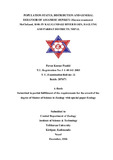Please use this identifier to cite or link to this item:
https://elibrary.tucl.edu.np/handle/123456789/1396| Title: | Population Status, Distribution and General Behavior of Assamese Monkey (Macaca Assamensis Mcclelland, 1840) in Kaligandaki River Basin, Baglung and Parbat Districts, Nepal |
| Authors: | Pavan Kumar Paudel, Pavan Kumar |
| Keywords: | Macaque;Vegetation;Monkeys;Behavior |
| Issue Date: | 2016 |
| Publisher: | Central Department of Zoology Institute of Science and Technology Tribhuvan University Kirtipur, Kathmandu |
| Abstract: | This study is focused on Assamese Macaques population, distribution, general behavior and vegetation associated with their habitats in Kaligandaki River Basin especially in Baglung and Parbat Districts, Nepal. The field survey was conducted mainly from “9 November, 2015” to “28 June, 2016” to explore the population dynamics of Assamese Macaque. The total area of 104.70 km 2 was surveyed; data were collected by total count method, questionnaire survey, and vegetation analysis by random sampling method and behavioral data were collected by scan sampling method to a particular troop. The total population of Assamese Macaques during the study period was 47 individuals in four different troops. The group density was found to be 0.038 groups/km 2 with a population density of 0.44 individuals/km 2 and a mean group size of 11.75 (range 3-16) individuals. Age-sex composition of macaque comprised 23.40% adult males, 19.14% adult females followed by 17.02% sub adult male, 19.14% young adult female, 14.8% juveniles and 6.38% infants. Adult sex ratio was observed 1:0.81 i.e. 122 males per 100 females and the recruitment rate was found 0.33. i.e. 33 infants per 100 females. The distribution pattern of Assamese Macaques among four different study blocks was found clumped distribution in the habitat. There was significant difference in distribution of Assamese Macaques among four different blocks (χ 2 = 6.2996, d.f.= 3, p = 0.09791, p>0.05). Total of 1640 scan samples were recorded from the focal Aduwabari Troop during the study period. The focal troop revealed that foraging was 47%, moving 28%, resting 14% and grooming 11%. By Quadrate sampling, 58 plant species with 716 number were recorded. this study revealed that Sal (Sorea robusta) is the dominant plant species with relative density 31.42% and relative frequency 8.376% followed by Tiju (Diospyros malabarica) relative density 10.93% and relative frequency 8.376%. Among the crop raided by Assamese Macaques, maize cubs were found to be highly prefered and was 46.95%, followed by 15.91% paddy, 15.11% potato, 10.84% millet, 6.88% wheat, 2.05% pulses, 1.59% fruits and 0.66% vegetables. The most commonly used crop protection strategy was guarding the field 50% followed by scarecrows 25%, using dogs 20% and 5% tin box and catapult |
| URI: | http://elibrary.tucl.edu.np/handle/123456789/1396 |
| Appears in Collections: | Zoology |
Items in DSpace are protected by copyright, with all rights reserved, unless otherwise indicated.

